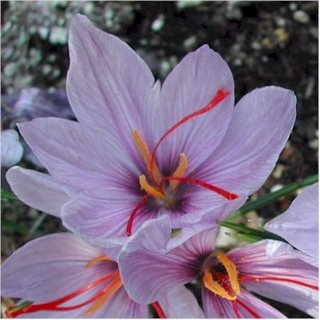 Crocus sativus, best known for its stigma and pollen (source of saffron, perhaps the most expensive spice in the world), has traditionally been linked to various medicinal effects, depending on the part used: from mood enhancement of the saffron itself, to the treatment of gout with the alkaloid colchinine found in its underground bulb. A very recent (6/06) study from Iran evaluated the use of the petals of this wonderful fall-blooming flower to determine its use in a small sample (n=40) of individuals who me the diagnostic criteria for mild to moderate depression. The results: "At 6 weeks, petal of C. sativus produced a significantly better outcome on Hamilton Depression Rating Scale than placebo (d.f.=1, F=16.87, p<0.001). There were no significant differences in the two groups in terms of observed side effects. The results of this study indicate the efficacy of petal of C. sativus in the treatment of mild-to-moderate depression".
Crocus sativus, best known for its stigma and pollen (source of saffron, perhaps the most expensive spice in the world), has traditionally been linked to various medicinal effects, depending on the part used: from mood enhancement of the saffron itself, to the treatment of gout with the alkaloid colchinine found in its underground bulb. A very recent (6/06) study from Iran evaluated the use of the petals of this wonderful fall-blooming flower to determine its use in a small sample (n=40) of individuals who me the diagnostic criteria for mild to moderate depression. The results: "At 6 weeks, petal of C. sativus produced a significantly better outcome on Hamilton Depression Rating Scale than placebo (d.f.=1, F=16.87, p<0.001). There were no significant differences in the two groups in terms of observed side effects. The results of this study indicate the efficacy of petal of C. sativus in the treatment of mild-to-moderate depression".The authors recommend additional research, and larger-scale trials. I fully agree!
What is most interesting to me about this study is the fact that the petals of the crocus were used, rather than the more commonly studied (and way more expensive) stigmas. The researchers used capsules filled with the powdered petals, but pending some additional pharmacological research, I would tentatively say that the traditional hydroalcoholic tincture might be equally, and perhaps more, effective. Nevertheless, this presents a sustainable, affordable, effective, beautiful, and easy-to-grow option for mild to moderate depression.
Full abstract from Phytomedicine.
No comments:
Post a Comment